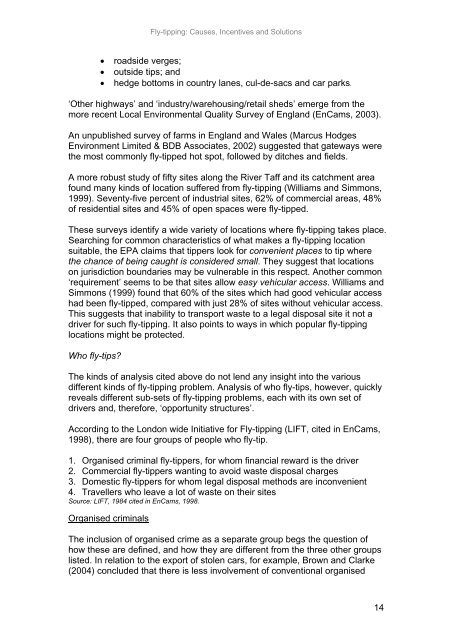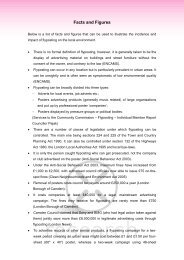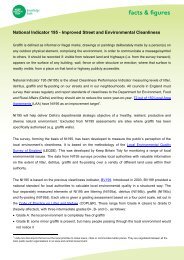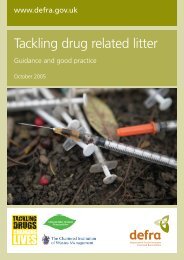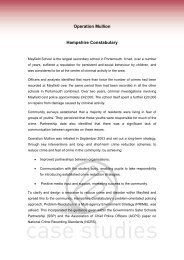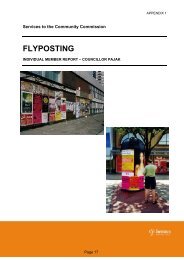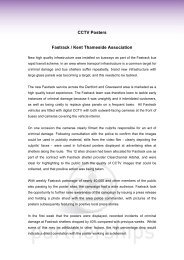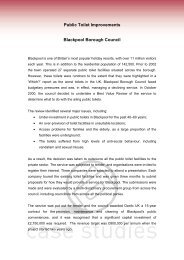Fly-tipping: Causes, Incentives and Solutions - Keep Britain Tidy
Fly-tipping: Causes, Incentives and Solutions - Keep Britain Tidy
Fly-tipping: Causes, Incentives and Solutions - Keep Britain Tidy
Create successful ePaper yourself
Turn your PDF publications into a flip-book with our unique Google optimized e-Paper software.
<strong>Fly</strong>-<strong>tipping</strong>: <strong>Causes</strong>, <strong>Incentives</strong> <strong>and</strong> <strong>Solutions</strong><br />
• roadside verges;<br />
• outside tips; <strong>and</strong><br />
• hedge bottoms in country lanes, cul-de-sacs <strong>and</strong> car parks.<br />
‘Other highways’ <strong>and</strong> ‘industry/warehousing/retail sheds’ emerge from the<br />
more recent Local Environmental Quality Survey of Engl<strong>and</strong> (EnCams, 2003).<br />
An unpublished survey of farms in Engl<strong>and</strong> <strong>and</strong> Wales (Marcus Hodges<br />
Environment Limited & BDB Associates, 2002) suggested that gateways were<br />
the most commonly fly-tipped hot spot, followed by ditches <strong>and</strong> fields.<br />
A more robust study of fifty sites along the River Taff <strong>and</strong> its catchment area<br />
found many kinds of location suffered from fly-<strong>tipping</strong> (Williams <strong>and</strong> Simmons,<br />
1999). Seventy-five percent of industrial sites, 62% of commercial areas, 48%<br />
of residential sites <strong>and</strong> 45% of open spaces were fly-tipped.<br />
These surveys identify a wide variety of locations where fly-<strong>tipping</strong> takes place.<br />
Searching for common characteristics of what makes a fly-<strong>tipping</strong> location<br />
suitable, the EPA claims that tippers look for convenient places to tip where<br />
the chance of being caught is considered small. They suggest that locations<br />
on jurisdiction boundaries may be vulnerable in this respect. Another common<br />
‘requirement’ seems to be that sites allow easy vehicular access. Williams <strong>and</strong><br />
Simmons (1999) found that 60% of the sites which had good vehicular access<br />
had been fly-tipped, compared with just 28% of sites without vehicular access.<br />
This suggests that inability to transport waste to a legal disposal site it not a<br />
driver for such fly-<strong>tipping</strong>. It also points to ways in which popular fly-<strong>tipping</strong><br />
locations might be protected.<br />
Who fly-tips?<br />
The kinds of analysis cited above do not lend any insight into the various<br />
different kinds of fly-<strong>tipping</strong> problem. Analysis of who fly-tips, however, quickly<br />
reveals different sub-sets of fly-<strong>tipping</strong> problems, each with its own set of<br />
drivers <strong>and</strong>, therefore, ‘opportunity structures’.<br />
According to the London wide Initiative for <strong>Fly</strong>-<strong>tipping</strong> (LIFT, cited in EnCams,<br />
1998), there are four groups of people who fly-tip.<br />
1. Organised criminal fly-tippers, for whom financial reward is the driver<br />
2. Commercial fly-tippers wanting to avoid waste disposal charges<br />
3. Domestic fly-tippers for whom legal disposal methods are inconvenient<br />
4. Travellers who leave a lot of waste on their sites<br />
Source: LIFT, 1984 cited in EnCams, 1998.<br />
Organised criminals<br />
The inclusion of organised crime as a separate group begs the question of<br />
how these are defined, <strong>and</strong> how they are different from the three other groups<br />
listed. In relation to the export of stolen cars, for example, Brown <strong>and</strong> Clarke<br />
(2004) concluded that there is less involvement of conventional organised<br />
14


